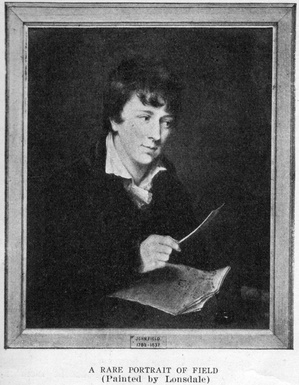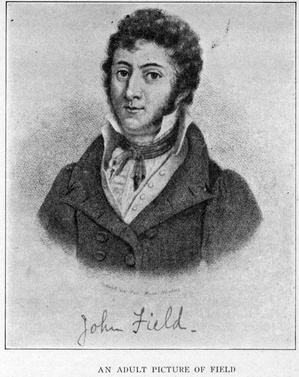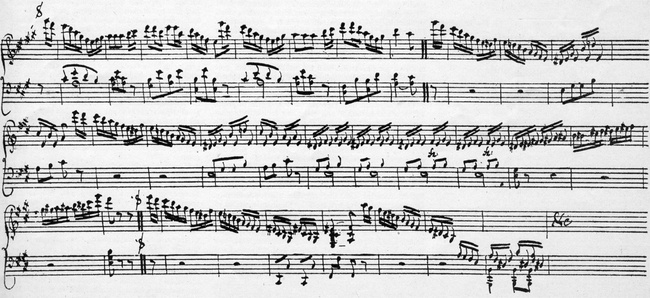Secured for The Etude by the Eminent Musicologist
W. H. GRATTAN FLOOD, Mus. Doc. K. S. G.
Together with unique portraits of the composer and a newly discovered youthful composition.
[Editor’s Note: William Henry Grattan Flood was born at Lismore, Ireland, 1859. His musical knowledge was largely self attained. At first destined for the priesthood, he decided to become a musician. He received a few lessons from Dr. Kerbusch and from Sir R. Stewart. After serving as organist in well-known churches including the Thurles Cathedral and Enniscorthy Cathedral, he became Professor of Music and Classical languages at St. Wilfrid’s College in Staffordshire. In 1907 the University of Dublin made him a Doctor of Music. He has been a contributor to the Grove Dictionary, the Catholic Encyclopedia and other important scholarly works and has written several books dealing with various phases of musical archeology.
John Field, probably the greatest musical genius produced by Ireland, was born at Dublin July 26, 1782, and died in Moscow in 1837. He came from an exceptionally musical family, his father being a violinist and his grandfather an organist. Dr. Flood now points out that Field’s mother was a composer. His parents were so ambitious to have the boy become great that they treated him with the sternest discipline at home. Later he was apprenticed to Clementi when the pianist-composer had embarked in the pianoforte business in London. There he was employed to show off pianos in Clementi’s warerooms and was given the strictest kind of training under a severe master. In 1804, Clementi sent Field to Petrograd where the young man remained, becoming a great success in his chosen work. Field wrote seven concertos, four sonatas and much other music for the pianoforte. He is best known, however, for the invention of the “Nocturne.” Up to that time almost all of the serious music written for the pianoforte took on the nature of the strictly contrapuntal works, such as, fugues of Bach and Handel, or was written in the form of sonatas or variations,—mostly sonatas. Field saw the advantage of writing in a much freer style and his composition of this type set the example for the Nocturne form employed by Chopin and others with such great success.]
 Who has not played some of Field’s Nocturnes? Who has not read Schumann’s eulogistic notice, almost rhapsodical, of Field’s Seventh Concerto? All pianists are acquainted with Liszt’s fine tribute to the Irish inventor of the art-form known as the Nocturne. The idea of scattered chords with sustained pedal was first developed by Field. No doubt Chopin developed the genre, but as Henry Vavey writes, “he did not altogether eclipse Field, the original inventor.” And yet, it is an extraordinary fact, that although there are monographs of Field in French, Italian, German, Flemish, Danish, and Russian, the only English memoir is that which was issued last year by the present writer, and published in an edition de luxe by Martin Lester, Ltd., Dublin.
Who has not played some of Field’s Nocturnes? Who has not read Schumann’s eulogistic notice, almost rhapsodical, of Field’s Seventh Concerto? All pianists are acquainted with Liszt’s fine tribute to the Irish inventor of the art-form known as the Nocturne. The idea of scattered chords with sustained pedal was first developed by Field. No doubt Chopin developed the genre, but as Henry Vavey writes, “he did not altogether eclipse Field, the original inventor.” And yet, it is an extraordinary fact, that although there are monographs of Field in French, Italian, German, Flemish, Danish, and Russian, the only English memoir is that which was issued last year by the present writer, and published in an edition de luxe by Martin Lester, Ltd., Dublin.
Among the new facts brought to light as the result of a patient search among the newspaper files in the Royal Irish Academy, Dublin, were the following:
1. Particulars relating to the father and the grandfather of the composer—both of whom were Irish.
2. An account of Field’s early training as a pianist by Tomaso Geoidani, who spent his latter years in Dublin.
3. The discovery of Field’s début in his native city on March 24, 1792.
4. A notice of Field as a composer at the age of eleven.
5. An account of Field’s departure from Dublin, and his apprenticeship to Clementi.
An Example of Field’s Precocity
This manuscript of Field bears the inscription “Composed by John Field, (aged 12 years).” This fragment shows Field’s fine sense of balance at a very early age.
I am privileged to place before the readers of The Etude the accompanying photograph of a sketch composed by Field “in his 12th year,” in 1796. The photo gives a cleaner reproduction of the original manuscript than any copy, and was especially taken for me by my friend Mr. Arthur J. Hill, F. S. A.,140 New Bond St., London, who possesses the manuscript. The fragment was written by Field for a Mrs. Alpe of Hardingham Hall, near Attleborough, Norfolk, and at this lady’s death was acquired by her grand-daughter, Mrs. Sconce. 79 Sinclair Road, Kensington, London, from whom Mr. Arthur J. Hill acquired it, in 1899.
Through the just kindness of Mr. Hill I was also given the original concert programmes of Field when in London. It is of interest to note that as early as 1798 Field composed a beautiful Concerto, which he played at Pinto’s benefit concert, at the Haymarket Theatre, on February 7, 1799. The Morning Chronicle of the following day describes him as “Master Field, a pupil of Clementi’s,” and it adds:-“This young gentleman, though only fifteen years of age has been esteemed by the best judges, one of the finest performers in this kingdom, and his astonishing display of ability on this occasion, proved how justly he was entitled to the distinction.”
 In 1800 and 1801 Field was the lion of the concert world in London, and in the latter years Clementi commissioned Lonsdale, a famous portrait painter, to paint the Irish composer, as a souvenir of their friendship and the termination of Field’s apprenticeship. This beautiful portrait was duly executed, and is now the property of Col. Collard, the grandson of Clementi. With the permission of Col. Collard, Mr. Arthur J. Hill commissioned a photographer to take a copy of the portrait, and presented it to me. This copy I herewith reproduce, and it is of unique interest, representing Field just before he accompanied Clementi on his journey to Russia. By way of comparison I also reproduce Moyers’ engraving.
In 1800 and 1801 Field was the lion of the concert world in London, and in the latter years Clementi commissioned Lonsdale, a famous portrait painter, to paint the Irish composer, as a souvenir of their friendship and the termination of Field’s apprenticeship. This beautiful portrait was duly executed, and is now the property of Col. Collard, the grandson of Clementi. With the permission of Col. Collard, Mr. Arthur J. Hill commissioned a photographer to take a copy of the portrait, and presented it to me. This copy I herewith reproduce, and it is of unique interest, representing Field just before he accompanied Clementi on his journey to Russia. By way of comparison I also reproduce Moyers’ engraving.
The year 1814 is memorable for the invention of the Nocturne and soon after, Field had as a pupil the famous Glinka, the founder of Russian National Opera and of the Russian School of Music.
Field accepted the invitation of the Philharmonic Society of London to play at their Concert on February 27, 1832. He also played at the Haydn Centenary on March 31, when Cramer and Moscheles also assisted. Two days previously (March 29) he was one of the chief mourners at the public funeral accorded to his old master Clementi, who was interred in Westminster Abbey. On April 27 he played for the New Musical Fund “for the relief of decayed Musicians;” and on May 6th, he foregathered with Mendelssohn at a reception given Gelloscheles.
Further particulars of Field will be found in the new edition of Grove’s “Dictionary of Music and Musicians,” and it is here merely necessary to state that he died in Moscow on January 11, 1837.




